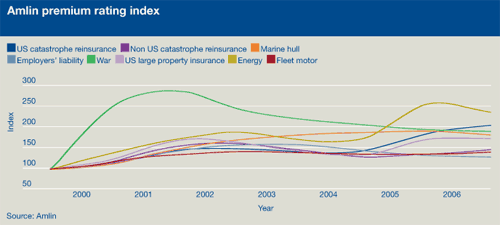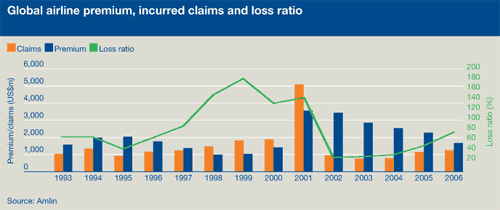Operating & Financial Review
2006 market overview
|
Trading environment in 2006
2006 witnessed increasing divergence in the pricing cycle between classes of business and even within the same class geographically.
In the latter part of 2005 it became apparent that the impact of hurricanes Katrina, Rita and Wilma, would have a material impact on the industry, forcing some reinsurers to cease trading and others to reduce materially their exposures to Eastern seaboard and Gulf of Mexico US property business. Meanwhile, demand for cover would rise as insurers sought to protect already reduced or more exposed balance sheets. As expected, this resulted in material price increases for US catastrophe exposed cover, where Amlin has involvement through its property insurance and reinsurance, as well as energy insurance, accounts. The start up of Amlin Bermuda for 2006 significantly enhanced the Group’s position in these areas.
Price increases in US catastrophe exposed classes accelerated through 2006 as the industry took on board the effects of changing loss frequency and severity assumptions used in catastrophe models, as rating agencies demanded higher capital for catastrophe risk, and as the level of protection offered by the retrocessional reinsurance (reinsurance of reinsurers) market shrunk whilst significantly more was charged for the cover offered. Most clients purchased additional cover irrespective of location and underlying exposures. There was a clear shortage of capacity in a number of peak zones, including the north-east US, the Gulf of Mexico and California. At the 1July renewals which preceded the US windstorm season, catastrophe reinsurance renewal rates were up between 10% and 50% depending on the location and nature of cover.
However, these rate increases need to be considered relative to the increased expectations of loss severity and frequency resulting from the belief which scientists now have concerning the impacts of global warming. AIR, one of the leading catastrophe modelling agencies, considers that near term elevated sea surface temperatures could increase previously modelled US windstorm losses by an average of some 36% across all coastal states.
Other territories in the reinsurance arena did not respond as dramatically and terms in non-peak zones, mainly outside the United States, were flat. As the year progressed there were increasing signs of competition for business outside peak zones as some of the more US centric reinsurers sought to diversify their exposures.
Elsewhere, the insurance markets displayed flat to downward pressure on rates. Most classes continued to offer good margin potential but UK commercial and airline insurance came under the greatest pressure.
Among our UK commercial classes competition for fleet motor business remained intense for new business even though a number of participants made encouraging statements about their intentions. UK liability insurance, particularly professional indemnity and employers liability, continued to see rate reductions.
New competition entered the airline insurance market in 2006 encouraged by the absence of a major airline disaster since the American Airlines crash in Queens, New York, in November 2001.
Estimated total worldwide airline premiums have now reduced from $4 billion to US$1.7 billion since 2001 while many liability limits offered on major airlines operating aircraft, such as the Boeing 747, have increased towards US$2 billion.
In 2006, even without a major airline disaster, claims are estimated at some US$1.3 billion which leaves little room for a major disaster. Rates in most other aviation classes have, however, remained flat offering good margin potential.
The chart below, which displays Amlin’s renewal rating movements for some major classes of business demonstrates the increased divergence in the cyclical pricing trends referred to above.


